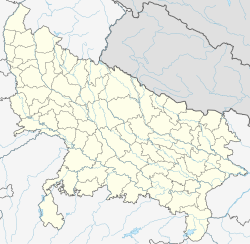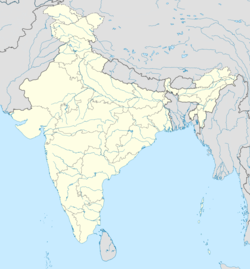Top Qs
Timeline
Chat
Perspective
Kuraoli
Town in Uttar Pradesh, India From Wikipedia, the free encyclopedia
Remove ads
Kuraoli is a town and a nagar panchayat (urban municipality) in Mainpuri district in the Indian state of Uttar Pradesh. Kuraoli was known for Rathore thakur state in 18th century, now it is known for its largest garlic and onion mandi in Uttar Pradesh.
This article needs additional citations for verification. (December 2017) |
Remove ads
Name
According to Paul Whalley, the name Kurāolī may be derived from koṭ, meaning "fort"; he reconstructed the hypothetical original name as *Koṭ-ā-vala, "having a fort", patterned after Sanskrit dantāvala ("tusked"). The name Kuraulī would be a further contracted version of the same name.[2]: 54
Geography
Kuraoli is located in the northern corner of Mainpuri district,[3]: 223 about 22 km from the town of Mainpuri.[4]: 281 The main road linking Mainpuri and Etah passes through here.[3]: 223
History
Summarize
Perspective
Kuraoli in the 18th century was in the kingdom of Rathore Thakur State ruled by King Laxman Singh, his three Queen's forts was built on 80 bigha of land, 100 metres east of the palace. Queen's Puja Place, was in North Direction about 100 m away, was a pucca pond of about 2 bigha, around the corners of the pond there were wells, As the pond has to be flooded all the time hence the wells do not show up.[5]
There is a 25 km long tunnel which leads to Mainpurik Maharaj Tej Singh's fort.
There were three brothers, who were priests in the king's court, Once the king insulted the three and angered them. They cursed the king, destroying the king's empire.
Those three priests rest in afterlife in different places. These location seems to be famous for melas today, and these places are these names
- Under Galanath Bridge Pipra
- Under Chandrapura Pipara
- Hanuman Temple Under The Papra
After Holi, the mela is held at these three places.
At the turn of the 20th century, Kuraoli was described as an "open and well-built", if small, town, with a number of fine houses belonging to prosperous merchants. The town was split into two separate parts by the Etah-Mainpuri road, which was then part of the Grand Trunk Road. Kuraoli proper, which included six hamlets, lay to the north of the road. To the south of the road was Sujrai, which was technically a separate settlement but was counted as part of the town. The main highway ran between the two distinct built-up areas at full width, without narrowing to a regular city street like in nearby towns like Bhongaon or Bewar. While highway itself served as the main marketplace for those towns, Kuraoli was different – the main marketplace was on a side street away from the highway, while the highway itself only had a couple of shops on it. Kuraoli's market, and the shops inside it, were owned by the raja of Sujrai.[3]: 223
Kuraoli was described as only having risen to prominence rather recently at that point. It functioned as the main market centre for the surrounding countryside, and had a small net export of grain. At that point it had a post office, police station, and school teaching in the Hindustani language. The school was located in the middle of the town's main marketplace. The town then had 9 mosques and 21 Hindu temples. The oldest temple was the one built by the Kayasth qanungos, which was "not much more than a century" old at that point. The town was also noted for its local ophthalmologists known as the Satias, who exclusively treated cataracts; there were about 10 to 12 families of this group.[3]: 223, 226
Remove ads
Demographics
Summarize
Perspective
As of the 2011 census, Kuraoli had a population of 24,969, in 4,161 households. This population was 52.5% male (13,108) and 47.5% female (11,861). The 0-6 age group numbered 3,432 (1,838 male and 1,594 female), or 13.7% of the total population. 4,124 residents were members of Scheduled Castes, or 16.5% of the total. The town's literacy rate was 73.4% (counting only people age 7 and up).[6]: 174–5
An estimated 2,520 people live in slum conditions in Kuraoli as of 2011, in the four neighbourhoods of Bheemnagar, Kuvarpur, Khujrai, and Kanoon Goyan.[1]: 323
As of 2001[update] India census,[7] Kuraoli had a population of 20,680. Males constitute 53% of the population and females 47%. Kuraoli has an average literacy rate of 56%, lower than the national average of 59.5%: male literacy is 65%, and female literacy is 47%. In Kuraoli, 17% of the population is under 6 years of age.
Remove ads
Economy
Among biggest industries in Kuraoli are the making and processing of groundnut oil, wooden goods, and rice.[4]: 291 Shoes, slippers, and furniture are among the most important manufactured goods produced in Kuraoli. As of 2009, Kuraoli had 2 nationalised banks, 0 private commercial banks, 1 cooperative bank, and 1 agricultural credit society.[1]: 321–2
Infrastructure
As of 2011, Kuraoli has 1 hospital with 30 beds, 15 medicine shops, 7 schools teaching at the primary level, and 4 schools teaching at the secondary level. There is no public library. Drinking water is provided by tube well/borehole and stored in service reservoir(s), with a total capacity of 1,400 kilolitres. There is no local fire department; the closest is in Mainpuri.[1]: 314–20
List of villages under Kuraoli block
The following 103 villages are counted as part of Kuraoli CD block:[1]: 88–90
- Akbarpur Jhala
- Alupura
- Araji Tarwali
- Ashokpur
- Ashokpur
- Athpura
- Balipur
- Balrampur
- Barauliya
- Barkhera
- Basura Sultanpur
- Beekapur
- Belahar
- Bhanpur
- Bharatpur
- Bichiya Vikrampur
- Bikrampur
- Birasinghpur
- Chandrapur
- Dahipagar
- Dangan
- Devinagar
- Devkali
- Dharendra
- Dhivaiya
- Divrayi
- Dulhapur
- E. Balabhpur
- E. Hirapur
- E. Khas
- E. Mahloyi
- E. Manjhpati
- E. Gopalpur
- E. Sari
- Fatehjangpur
- Firozpur
- Gahiyarpur
- Ganeshpur
- Ganga Jamuni
- Gangapur Muhabatpur
- Gariya
- Ghuslenda
- Gokulpur
- Gulalpur
- Hafizpur
- Harmadhakarpur
- Hatu Mubarakpur
- Jakhaua
- Jamlapur
- Jigan Chandai
- Jiyoli Ghingarpur
- Junhensa
- Jyoti (rural)
- Kalyanpur
- Kanchanpur
- Kanikpur
- Karanpur
- Khichauli
- Khiriyapiper
- Khirna
- Kichaura
- Kishanpur
- Kookamai
- Kumhraua
- Lakhaura
- Laxmipur
- Madhkarpur
- Mahadeva Jagatpur
- Makboolpur
- Manauna
- Mithawali Kalan
- Mithawali Khurd
- Mugaliyapur
- Nagla Daulat
- Nagla Usar
- Nagriya
- Nanamau
- Nasratpur Dehat
- Naugaon
- Naurangpur
- Nijampur
- Paharpur
- Panwah
- Rajapur
- Rampura
- Rasemar
- Richpura
- Rosingpur
- Rustampur
- Sahadattpur
- Salempur
- Saray Latif
- Sharifpur
- Sidpura
- Sirsa
- Soni
- Sujanpur
- Sujrai Dehat
- Tarauli
- Thorwa
- Timanpur
- Uddetpur Har Khatkani
- Uddetpur Paramkuti
- Vishunpur
Remove ads
References
Wikiwand - on
Seamless Wikipedia browsing. On steroids.
Remove ads

